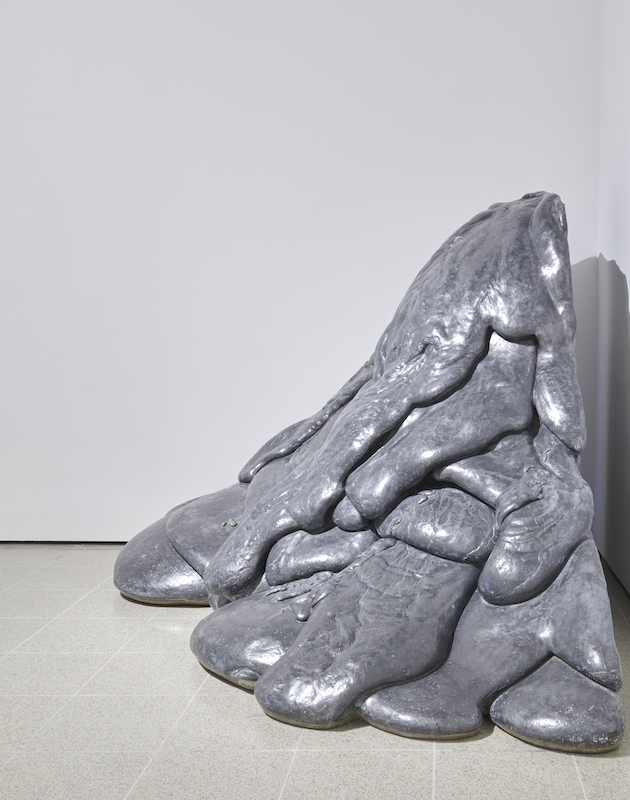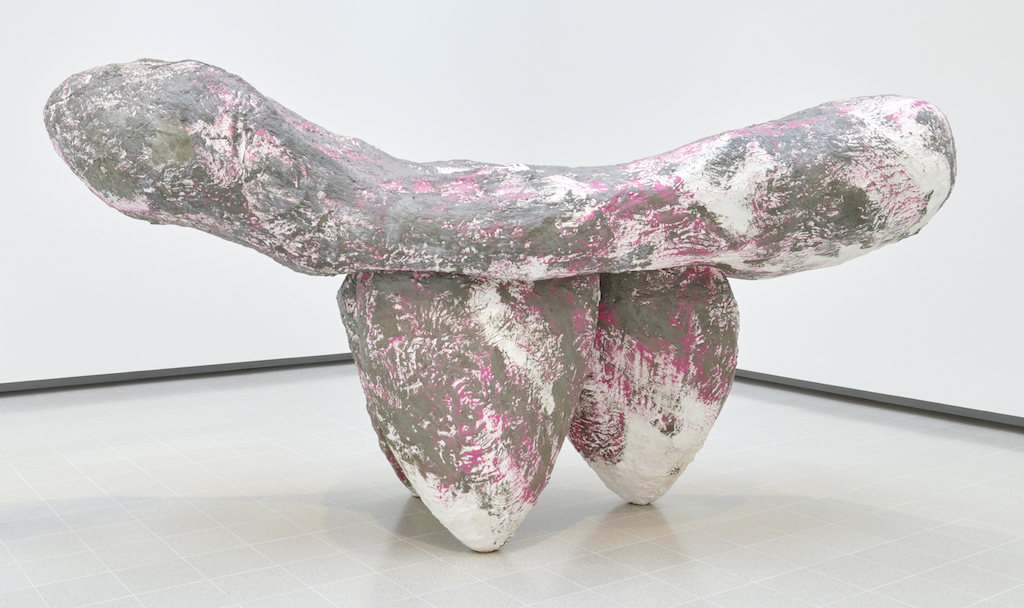Under the guidance of director Ralph Rugoff, the Hayward Gallery seems hell bent on reducing art to the level of fun for all the family. And as though to prove the point, cretinous captions strip the work of all meaning beyond the banal, while press pictures showcase kids gazing at large sculptures.
Their latest exhibition, When Forms Come Alive consists of sculptures by 21 artists, all of whom employ organic rather than geometric forms. “Dynamic, exuberant and playful, the works in this show, take visitors on an adventure into a world of fascinating forms,” says Rugoff.
 The “adventure” begins in the project space, which is filled with Pumping, an installation by Spanish artist Eva Fábregas of bright pink inflated tubes resembling a tangle of giant intestines with an 8 channel soundtrack of dance music. The piece is reminiscent of an immersive kids’ play space, but you aren’t allowed to jump on the tubes, so in terms of “adventure” a bubble room or bouncy castle would have been more satisfying.
The “adventure” begins in the project space, which is filled with Pumping, an installation by Spanish artist Eva Fábregas of bright pink inflated tubes resembling a tangle of giant intestines with an 8 channel soundtrack of dance music. The piece is reminiscent of an immersive kids’ play space, but you aren’t allowed to jump on the tubes, so in terms of “adventure” a bubble room or bouncy castle would have been more satisfying.
And there’s the rub; most kids like to explore things physically – to touch, climb, yell, run and scream – all of which, thankfully, are still taboo in galleries. So if you present sculpture as little more than a sensory experience bereft of further meaning, you do artists and viewers a grave disservice.
The exhibition contains some first rate art, but you’d be hard pressed to see it as such. Take Lynda Benglis’s Quartered Meteor 1969 (pictured above right), for example. Slumped in the corner of an upstairs room is a heap of grey matter resembling congealed lava. There’s something compellingly about this flaccid lump of inertia; its shape seems to have arisen naturally – from the way molten lead (from which it is made) flows, flops and solidifies when cooling. The caption quotes the artist as saying “I like things that flow” and implies that there’s nothing else to know – which is to miss the point entirely.
 Benglis first made the piece in brightly coloured polyurethane, chosen for its lack of fine art credentials. The anti-heroic shape was a riposte to the minimalist art filling New York’s galleries at the time. In the male-dominated art world of the 1960s, so-called rational geometry was king while sagging forms perceived as feminine were taboo. Using droopy shapes that succumb to gravity was, therefore, a political act. And it gets more complicated; the form of this lead version may appear natural when, actually, it’s a cast of the polyurethane original. Rather than highlighting how molten lead behaves, the artist’s main aim was to subvert a perceived hierarchy of forms and to overlook that is to completely misrepresent the work.
Benglis first made the piece in brightly coloured polyurethane, chosen for its lack of fine art credentials. The anti-heroic shape was a riposte to the minimalist art filling New York’s galleries at the time. In the male-dominated art world of the 1960s, so-called rational geometry was king while sagging forms perceived as feminine were taboo. Using droopy shapes that succumb to gravity was, therefore, a political act. And it gets more complicated; the form of this lead version may appear natural when, actually, it’s a cast of the polyurethane original. Rather than highlighting how molten lead behaves, the artist’s main aim was to subvert a perceived hierarchy of forms and to overlook that is to completely misrepresent the work.
There are sculptures, of course, that don’t benefit from explanation – that are so self-evident they make words irrelevant. Made from Alaskan yellow cedar, Martin Puryear’s Untitled (2013) (pictured left) traces a slender arc down the wall that is so perfect it silences speech. And Shylight (2006-14) (main picture) by DRIFT (Lonneke Gordijn and Ralph Nauta) is another delight. A shoal of lights descends from the ceiling, then wafts back up again in a choreographed sequence. Dressed in white frills that open and close like tiny umbrellas, they are reminiscent of jelly fish navigating the ocean depths.
Most works, though, are enriched by explanation. The caption says that Senga Nengudi’s RSVP Reverie ‘D’ (2014) “relates to the human body”, without saying how or why. But it helps to know that Nengudi began using tights in her work when she was pregnant – to reflect the strain on the mother’s body as it expands to accommodate the growing foetus. “The body,” she says, “can only stand so much push and pull until it gives way, never to resume its original shape.” As an African American, she chooses colours ranging from black to tan to refer to women of all races. Pinned to the wall in configurations that stretch them to their limits, the tights create dynamic lines of tension while, filled with sand, the toes anchor them to the floor. Phyllida Barlow’s wry humour is extremely subtle. Her monumental Untitled: modern sculpture; 2022 (2022) (pictured above) is an ironic response to the self-important public sculptures jokingly referred to by Tom Wolfe as “the turd in the plaza”. The work’s awkward shapes and scuzzy surface are a knowing riposte to Henry Moore’s gleaming bronzes, so loved by rich corporations.
Phyllida Barlow’s wry humour is extremely subtle. Her monumental Untitled: modern sculpture; 2022 (2022) (pictured above) is an ironic response to the self-important public sculptures jokingly referred to by Tom Wolfe as “the turd in the plaza”. The work’s awkward shapes and scuzzy surface are a knowing riposte to Henry Moore’s gleaming bronzes, so loved by rich corporations.
To fully appreciate Franz West’s sculptures, similarly, it helps to know the context in which he worked. His irreverence was a reaction to the Viennese Actionists who, under the mantra “art is politics”, created performances that were violent demonstrations of rage and angst. Made of cheap materials like papier maché and polystyrene, West’s sculptures are deliberately tacky and absurd. In Cain Approaching Abel 2009 (pictured below), for instance, he portrays the Old Testament brothers as posturing and incompetent boxers, their sibling rivalry embodied in knobbly erections. The caption refers to the work as slapstick, which reduces it to little more than a daft joke. This kind of dumbing down simply doesn’t work; art is rarely designed merely to entertain so trying to force it to be amusing inevitably leads to failure.
The caption refers to the work as slapstick, which reduces it to little more than a daft joke. This kind of dumbing down simply doesn’t work; art is rarely designed merely to entertain so trying to force it to be amusing inevitably leads to failure.
When Forms Come Alive includes some great works, but with this banal approach, the Hayward does its utmost to kill them off.
- When Forms Come Alive at the Hayward Gallery to May 6
- More visual arts reviews on theartsdesk










![SEX MONEY RACE RELIGION [2016] by Gilbert and George. Installation shot of Gilbert & George 21ST CENTURY PICTURES Hayward Gallery](/sites/default/files/styles/thumbnail_125_x_125_/public/mastimages/Gilbert%20%26%20George_%2021ST%20CENTURY%20PICTURES.%20SEX%20MONEY%20RACE%20RELIGION%20%5B2016%5D.%20Photo_%20Mark%20Blower.%20Courtesy%20of%20the%20Gilbert%20%26%20George%20and%20the%20Hayward%20Gallery._0.jpg?itok=3oW-Y84i)




Add comment